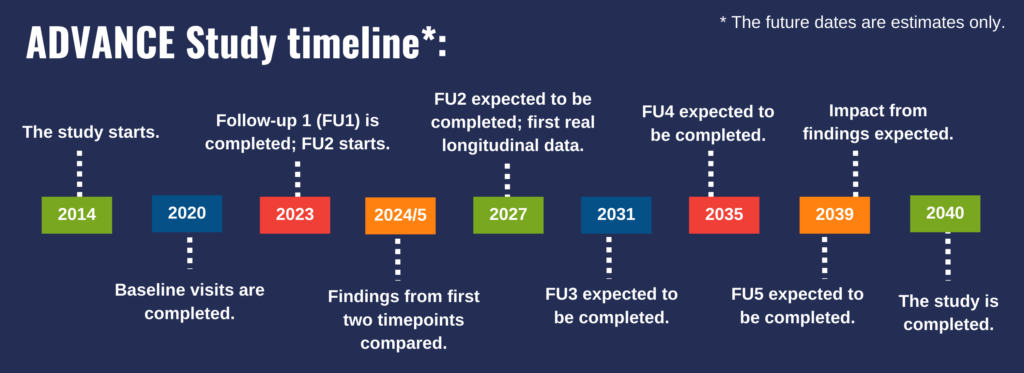Big thanks to all our participants and the ADVANCE team for being part of ADVANCE since the study started in 2014. The participants have now completed the first round of the 5 follow-ups, which means that we can now compare two time points and see if any trends in the data are starting to appear. The follow-up 1 data is being prepared by the ADVANCE team, and our researchers are excited to start analysing the data in early 2024, with some findings expected later in the year.
The below timeline shows when we think big ADVANCE milestones will be reached between now and the end of the study in 2040. (The dates shown are estimates only.)

But what about the findings so far from the baseline visits? You might remember seeing the baseline findings in previous newsletters. Below we summarise the key findings from the study to date. A full list of ADVANCE scientific publications can be found here, along with short summaries of the key publications. These are the published key findings from the ADVANCE baseline data so far:
- Cardiovascular risk was found to be slightly increased in the injured cohort compared to the uninjured cohort, but the differences are not big enough to warrant any medical treatment at this stage.
- The injured non-amputees were found to have greater rates of depression, anxiety and post-traumatic stress disorder (PTSD) compared to those with amputations and the uninjured participants. Participants with amputations and the uninjured participants reported similar rates of mental health issues.
- Participants with amputations reported greater rates of post-traumatic growth (PTG) compared to the injured non-amputees and the uninjured group. Pain was associated with a higher likelihood of reporting PTG.
- Lower bone mineral density was seen in the hip of the amputated side of participants with amputation injuries compared to the rest of the cohort. No other significant differences in bone health were seen within the cohort.
- Heart rate variability (HRV) was found to be lower in the injured group compared to the uninjured group.
